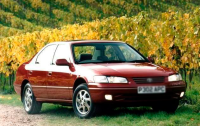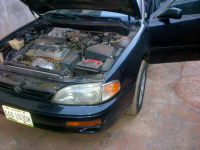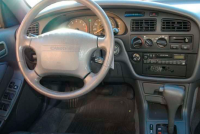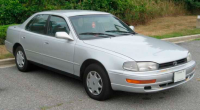The legendary Japanese car company Toyota made a big bet on the Camry models in the 1990s. With the arrival of the 21st century, their stakes for it have doubled, but it was the 1996 model year Toyota Camry that started it all.
Development history
The car's body was produced under the designation XV20. Notably, a coupe and convertible body appeared in this generation. This variant was named Solara, which the Japanese launched into production in 1998 and 2000 respectively.

In 1996, the sedan began production in Japan, but they did not appear on the market in the US and Australia until late 1997. The model was imported to Russia from overseas, and more often from the East, so most were right-hand drive.
Car equipment
The most popular model Toyota Camry until 2001 was produced in the sedan body with four doors. It had two powertrain types and three configuration options:
2.2L on manual transmission;
2.2 litre with automatic transmission;
3.0 litre with automatic transmission.
"The manual was a five-speed manual and the automatic was a four-band. Younger engines developed 131 hp, and the elder brother gave 190 "horses".
In terms of dimensions the car fit the standard of a family sedan for 1996. The length of the car was almost five meters (4760 mm). Width was just under 2 meters (1780 mm). The height was in the usual and comfortable range (1430 mm). Despite its size, it weighed not more than 1.5 tons (1400 kg), with a maximum permissible curb weight of 1500 kg.
The braking system was different, with drum brakes at the rear and disc brakes at the front. The fuel tank holds no more than 70 litres. It took 11.7 seconds for the 1996 Toyota Camry to reach a hundred kilometres per hour.
The 2001 Toyota Camry and up were described as having a maximum fuel consumption of 7.4 litres per gallon. In the city this figure reached 13.5 litres, and in the mixed cycle 9.6 litres.
Operation, advantages and disadvantages of the car
 The 1999 Toyota Camry - the generation at the turn of the century - became an icon of comfort for many contemporaries at the time. Already at that time, the car had many options:
The 1999 Toyota Camry - the generation at the turn of the century - became an icon of comfort for many contemporaries at the time. Already at that time, the car had many options:
electronic ride control;
climate control by ECU;
electrically operated sunroof;
electric adjustment of the front seats;
auto-adjustment of headlights.
In terms of technical characteristics, the Japanese did not differ much in general terms from representatives of other brands. However, quality and reliability of Oriental engineers made a buyer seriously think about choosing, for example, Toyota Camry 2000 and other foreign cars of similar class. Generation of Japanese sedan Toyota Camry of 1996 model year is notable not only for longevity of units, but also for good dynamic characteristics.
The car has very soft and smooth running, which is doubly noticeable on rough roads. Power of the engine allowed to pick up speed quickly, and good noise insulation created exceptional comfort while driving.

What challenges do modern owners have to face?
No matter how good and reliable the car is, time will take its toll. Today, looking at the photos, these cars already seem old-fashioned, with relatively square and straightforward forms. Aesthetics are the exterior and the first downside of the car now. The car lacks many of the electronic auxiliary features that modern examples are equipped with.
When buying a trimmed 2000 Toyota Camry, for instance, the new owner will be faced with the need to replace virtually the entire suspension. One should pay attention to water pump, which tends to loosen after 2-3 years of exploitation in these versions.
Japanese producers have not in vain given a six-year warranty for metal corrosion, because till that moment the body really preserved its luster. However, 15-year-old cars can already start having rust problems.
Reviews
Experience of 13 years, have been driving a Toyota Camry for 7 years.
My 1997 Toyota Camry turned 20 years old the other day! I celebrated the occasion like a holiday because despite its age, it continues to run perfectly. I remember picking it up 7 years ago, choosing it practically from a picture. The car is a workhorse. I certainly look after it and look after it, but even without that it has never let me down. It starts in winter even in severe frost and doesn't overheat in summer. I had to change a lot of things in it, but the most surprising is that I have never overhauled the engine.
Conclusion
Toyota Camry, even with 20 years of history, continues to delight its owners with comfort in motion and reliability in operation. The car of that time has all the necessary options for driving comfort. Today, the sedan is still popular due to its low maintenance costs and the durability of its working systems.


-rear-and-front-view-camera-6.png)

